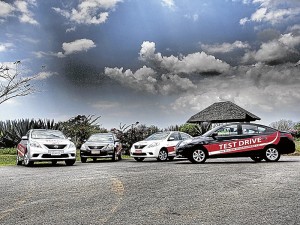On paper the new Nissan Almera makes each rival in its class look like bum wad. First, it impresses us with its size—considered to be the biggest and most spacious in its class. Then, it dazzles us with features otherwise found in upscale cars.
But like all enviable physical qualities, it’s the size that has automatically ingrained itself in our mind—as if Nissan has taken a Freudian snapshot of the Filipino mind, that a car is never personal, always familial; or as if Nissan has taken a page from Samsung’s book, that in order to beat turn-of-the-century mobile phone giant Nokia, it must super-size its features at super competitive pricing.
Nissan Almera starts with four wide-opening doors that allow easy access to the interior that is notably larger than class rivals. In fact, the rear compartment knee room is actually more generous than that offered in some premium D segment cars. Space could be the new frontier in saloon car, and Nissan wants to lead that race.
“Almera is redefining the standards of a B-segment car,” says Nissan Motor Philippines senior vice president for marketing Lee Junia. “It is specifically designed to meet the unique demands of the B-segment market in the Philippines but ups the game by offering an upscale feel and C-segment spaciousness at a B-segment price.
As a matter of fact, Junia is quick to retort that the new Almera’s width is just 5 mm shy of BMW 525’s.
Then there’s the luggage area which, at 490 liters, is among the largest in its class. Looks can be deceiving as from the outside the extra large trunk is optically minimized by the sweeping roofline and rear window which blends into the trunk lid.
A wide opening lid reveals a deep and practical load space, free from obstructions—the trunk lid hinges, for example, are hidden while the tool roll and jack are stored away as not to interfere with the load space. Under the boot floor, there’s enough space to fit a full-sized spare tire.
All-important whistles
While I feel compelled to highlight the rear comfort fan—which speeds up the cooling of the cabin especially in our tropical climate—not found in other cars in its class, this pales in comparison with Almera’s standard safety features like ABS (antilock breaking system), EBD (electronic brakeforce distribution) and a Brake Assist System.
Then there are other notable safety features like the Protective Zone Body Structure, dual SRS (supplemental restraint) airbags, and low friction seatbelts.
And now for the deal breaker: It’s hard to imagine that a 1.5-liter engine can actually break the 25 kilometer per liter barrier which is the realm of modern sub-compacts.
But it did recently courtesy of motoring journalists Bam Olivares (driver) and Neil Pagulayan (navigator) with 25.790 km/l from Total San Fernando to Total Subic-Tipo via North Luzon Expressway and Subic-Clark-Tarlac Expressway last March 13.
The eco-run was pretty stringent since the organizer made sure every participating car was running with equal mass by adding water weights.
Bam claimed they got lucky with momentum. For other factors aside from driver’s skills and luck, Junia enumerates Nissan Almera’s inherent technology for fuel efficiency.
There’s the lightweight but rigid V (versatile) platform; the all-aluminum engine; the new-generation 1.5 liter CVCTC engine designed to provide excellent pulling power at low and mid RPM; redesigned transmission that produces excellent torque; Almera’s best-in-class drag coefficient; and Almera’s unique EPS which reduces engine load, maximizing output.
Since November, Nissan Almera is assembled at the Nissan Technopark in Sta. Rosa, Laguna, at an average of 150 units. It is one of four Nissan car models that are built here which include Grand Livina, X-Trail and Nissan Sentra 1.3L. This year, Junia says they are looking at increasing the production of Almera to 200.
Filipino-built for Filipinos
“Almera is 100-percent built by Filipinos for the Filipino market,” says Junia. “It’s one way for Nissan Philippines to contribute to our economy. While this means that our cost to produce per unit invariably increases since we have to invest in our factory and technology, we are glad to provide better job opportunity for our countrymen.”
Junia hopes the government steps up and support the heavy industry as well as it does with light industry such as business process outsourcing. “We are losing that ability to manufacture; this is where the automotive industry can contribute to the economy and sustain its growth.”
The new Nissan Almera comes in three variants—the 1.5L base manual at P710,000, the 1.5L base automatic at P760,000, and the 1.5L mid automatic at P830,000. It is available in four exciting colors: titanium gray, brilliant silver, alpine white, and bluish black.
